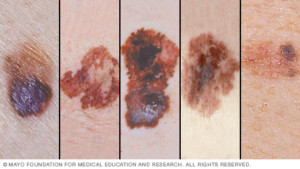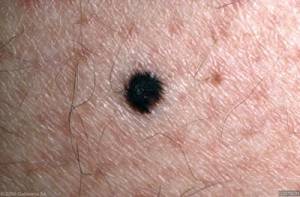There is so much more to the “A” for asymmetry in the ABCDE guidelines for checking moles for melanoma signs.
It’s crucial to know that the concept of asymmetry can easily be open to a little subjective interpretation, especially when the typical ABCDE guidelines leave room for more detail.
Usually, the ABCDE melanoma guidelines found in pamphlets or print/online articles on skin cancer define asymmetry in a way that some people might think means non-circular.
There’s also no mention in most generic guidelines that benign moles can appear asymmetrical, as the one above.
“Asymmetry in a suspicious lesion refers to both the internal structure as well as overall structure,” says Caroline A. Chang, MD, a board certified dermatologist and founder of the Rhode Island Dermatology Institute.
Dr. Chang explains, “While some normal moles will be slightly asymmetric, usually they have symmetry in at least one plane. Suspicious lesions tend to grow asymmetrically, with a fuzzy area branching out to one side but not the other.”

Five melanoma lesions; the second, third and fourth show considerable asymmetry, while all show dramatic color variation.
Naked-eye asymmetry means that if you divide the mole in half, the halves won’t match as far as shape.
Furthermore, a symmetrical mole can be oval or some other non-circular shape, yet equal or nearly equal on both sides if divided down the middle at any angle.
Know that normal moles can be divided in half and yield unequal appearances.
The larger a benign mole, the more easier asymmetry can be seen with the naked eye.
Have you ever seen a really large normal mole on a family member or friend that, no matter which angle you visually bisected it, the halves were obviously unequal?
Certainly, any uneven mole should be examined by a dermatologist, even if small.
Even if a mole has been uneven for as long as you can remember, have a dermatologist inspect it – and with a dermatoscope, not just naked eyes.
Asymmetry is a guideline, not a definitive sign of melanoma – especially since melanoma can actually be relatively symmetrical, as in the image below.

Source: pcds.org.uk/clinical-guidance/melanoma-an-overview1
A bisected melanoma that’s equal on both sides (equal in shape) may have sprung up in the absence of a pre-existing mole.
Or, it may have arisen within a mole that’s been present for years. The mole might naturally be very symmetrical, perhaps a near perfect circle.
But because the melanoma has started up in the center or close to the center of the mole, the shape of the mole has not (yet) been altered.
What can be seen during a skin exam might be a change in this mole’s central color, texture or height, while it can still be visually divided at any angle and yield perfectly equal sides.
Do not panic if you, upon examining your moles for the first time, discover some asymmetrical ones.
Every mole – even perfect circles of one solid color – needs to be inspected during monthly skin self-exams. Melanoma doesn’t always follow a template.
 Dr. Chang practices general and cosmetic dermatology and has a special focus on melanoma and the use of dermoscopy for mole monitoring.
Dr. Chang practices general and cosmetic dermatology and has a special focus on melanoma and the use of dermoscopy for mole monitoring.
 Lorra Garrick has been covering medical, fitness and cybersecurity topics for many years, having written thousands of articles for print magazines and websites, including as a ghostwriter. She’s also a former ACE-certified personal trainer.
Lorra Garrick has been covering medical, fitness and cybersecurity topics for many years, having written thousands of articles for print magazines and websites, including as a ghostwriter. She’s also a former ACE-certified personal trainer.
.



























